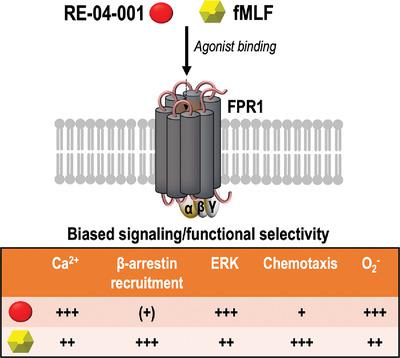当前位置:
X-MOL 学术
›
J. Leukoc. Biol.
›
论文详情
Our official English website, www.x-mol.net, welcomes your feedback! (Note: you will need to create a separate account there.)
Functional selective FPR1 signaling in favor of an activation of the neutrophil superoxide generating NOX2 complex
Journal of Leukocyte Biology ( IF 5.5 ) Pub Date : 2020-10-11 , DOI: 10.1002/jlb.2hi0520-317r Simon Lind 1 , Claes Dahlgren 1 , Rikard Holmdahl 2 , Peter Olofsson 2 , Huamei Forsman 1
Journal of Leukocyte Biology ( IF 5.5 ) Pub Date : 2020-10-11 , DOI: 10.1002/jlb.2hi0520-317r Simon Lind 1 , Claes Dahlgren 1 , Rikard Holmdahl 2 , Peter Olofsson 2 , Huamei Forsman 1
Affiliation

|
The formyl peptide receptors FPR1 and FPR2 are abundantly expressed by neutrophils, in which they regulate proinflammatory tissue recruitment of inflammatory cells, the production of reactive oxygen species (ROS), and resolution of inflammatory reactions. The unique dual functionality of the FPRs makes them attractive targets to develop FPR-based therapeutics as novel anti-inflammatory treatments. The small compound RE-04-001 has earlier been identified as an inducer of ROS in differentiated HL60 cells but the precise target and the mechanism of action of the compound was has until now not been elucidated. In this study, we reveal that RE-04-001 specifically targets and activates FPR1, and the concentrations needed to activate the neutrophil NADPH-oxidase was very low (EC50 ∼1 nM). RE-04-001 was also found to be a neutrophil chemoattractant, but when compared to the prototype FPR1 agonist N-formyl-Met-Leu-Phe (fMLF), the concentrations required were comparably high, suggesting that signaling downstream of the RE-04-001-activated-FPR1 is functionally selective. In addition, the RE-04-001-induced response was strongly biased toward the PLC-PIP2-Ca2+ pathway and ERK1/2 activation but away from β-arrestin recruitment. Compared to the peptide agonist fMLF, RE-04-001 is more resistant to inactivation by the MPO-H2O2-halide system. In summary, this study describes RE-04-001 as a novel small molecule agonist specific for FPR1, which displays a biased signaling profile that leads to a functional selective activating of human neutrophils. RE-04-001 is, therefore, a useful tool, not only for further mechanistic studies of the regulatory role of FPR1 in inflammation in vitro and in vivo, but also for developing FPR1-specific drug therapeutics.
中文翻译:

功能性选择性 FPR1 信号传导有利于中性粒细胞超氧化物生成 NOX2 复合物的激活
甲酰肽受体 FPR1 和 FPR2 由中性粒细胞大量表达,在其中它们调节炎症细胞的促炎组织募集、活性氧 (ROS) 的产生和炎症反应的消退。FPR 独特的双重功能使它们成为开发基于 FPR 的疗法作为新型抗炎疗法的有吸引力的目标。小化合物 RE-04-001 早先被确定为分化的 HL60 细胞中 ROS 的诱导剂,但该化合物的精确靶标和作用机制直到现在还没有阐明。在这项研究中,我们发现 RE-04-001 特异性靶向并激活 FPR1,并且激活中性粒细胞 NADPH 氧化酶所需的浓度非常低(EC 50约 1 nM)。RE-04-001 也被发现是一种中性粒细胞趋化剂,但与原型 FPR1 激动剂 N-甲酰基-Met-Leu-Phe (fMLF) 相比,所需的浓度相对较高,表明 RE- 04-001-activated-FPR1 具有功能选择性。此外,RE-04-001 诱导的反应强烈偏向于 PLC-PIP 2 -Ca 2+通路和 ERK1/2 激活,但远离 β-抑制蛋白募集。与肽激动剂 fMLF 相比,RE-04-001 更能抵抗 MPO-H 2 O 2 的灭活-卤化物系统。总之,这项研究将 RE-04-001 描述为一种新型的 FPR1 特异性小分子激动剂,它显示出一种偏向的信号特征,导致人类中性粒细胞的功能性选择性激活。因此,RE-04-001 是一种有用的工具,不仅可用于进一步研究 FPR1 在体外和体内炎症中的调节作用,还可用于开发 FPR1 特异性药物疗法。
更新日期:2020-10-11
中文翻译:

功能性选择性 FPR1 信号传导有利于中性粒细胞超氧化物生成 NOX2 复合物的激活
甲酰肽受体 FPR1 和 FPR2 由中性粒细胞大量表达,在其中它们调节炎症细胞的促炎组织募集、活性氧 (ROS) 的产生和炎症反应的消退。FPR 独特的双重功能使它们成为开发基于 FPR 的疗法作为新型抗炎疗法的有吸引力的目标。小化合物 RE-04-001 早先被确定为分化的 HL60 细胞中 ROS 的诱导剂,但该化合物的精确靶标和作用机制直到现在还没有阐明。在这项研究中,我们发现 RE-04-001 特异性靶向并激活 FPR1,并且激活中性粒细胞 NADPH 氧化酶所需的浓度非常低(EC 50约 1 nM)。RE-04-001 也被发现是一种中性粒细胞趋化剂,但与原型 FPR1 激动剂 N-甲酰基-Met-Leu-Phe (fMLF) 相比,所需的浓度相对较高,表明 RE- 04-001-activated-FPR1 具有功能选择性。此外,RE-04-001 诱导的反应强烈偏向于 PLC-PIP 2 -Ca 2+通路和 ERK1/2 激活,但远离 β-抑制蛋白募集。与肽激动剂 fMLF 相比,RE-04-001 更能抵抗 MPO-H 2 O 2 的灭活-卤化物系统。总之,这项研究将 RE-04-001 描述为一种新型的 FPR1 特异性小分子激动剂,它显示出一种偏向的信号特征,导致人类中性粒细胞的功能性选择性激活。因此,RE-04-001 是一种有用的工具,不仅可用于进一步研究 FPR1 在体外和体内炎症中的调节作用,还可用于开发 FPR1 特异性药物疗法。


























 京公网安备 11010802027423号
京公网安备 11010802027423号